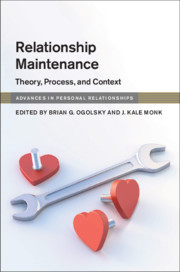Book contents
- Relationship Maintenance
- Advances in Personal Relationships
- Relationship Maintenance
- Copyright page
- Contents
- Tables
- Figures
- Contributors
- Part I Introduction
- Part II Theories of Relationship Maintenance
- Part III Processes of Relationship Maintenance
- Part IV The Social Context of Relationship Maintenance
- 14 Gender and Race Perspectives on Relationship Maintenance
- 15 Relationship Maintenance across Cultural Groups
- 16 Relationship Maintenance in the Age of Technology
- 17 Relationship Maintenance across the Life Course
- 18 Relationship Maintenance in Couple Therapy and Relationship Education
- Part V Conclusion
- Index
- References
18 - Relationship Maintenance in Couple Therapy and Relationship Education
from Part IV - The Social Context of Relationship Maintenance
Published online by Cambridge University Press: 02 December 2019
- Relationship Maintenance
- Advances in Personal Relationships
- Relationship Maintenance
- Copyright page
- Contents
- Tables
- Figures
- Contributors
- Part I Introduction
- Part II Theories of Relationship Maintenance
- Part III Processes of Relationship Maintenance
- Part IV The Social Context of Relationship Maintenance
- 14 Gender and Race Perspectives on Relationship Maintenance
- 15 Relationship Maintenance across Cultural Groups
- 16 Relationship Maintenance in the Age of Technology
- 17 Relationship Maintenance across the Life Course
- 18 Relationship Maintenance in Couple Therapy and Relationship Education
- Part V Conclusion
- Index
- References
Summary
In this chapter, we describe intervention efforts aimed at promoting maintenance behaviors in romantic relationships and the factors that influence these initiatives. We highlight current cultural forces surrounding clinical and educational practices, the definitions and theories that inform interventions to sustain and enhance partners’ maintenance behaviors, and important considerations for increasing the effectiveness of these interventions. The interventions featured in our review focus on enhancing positive aspects of relationships or mitigating threat to relationship maintenance processes within the cultural context of contemporary relationships. Suggestions for advancing the field include further research on the relevance of specific maintenance strategies and theories of change across the life course, the influence of cultural context and resilience on maintenance processes, unintended consequences of relationship maintenance interventions, and the evaluation process for interventions promoting maintenance behaviors.
Keywords
- Type
- Chapter
- Information
- Relationship MaintenanceTheory, Process, and Context, pp. 339 - 366Publisher: Cambridge University PressPrint publication year: 2019
References
- 1
- Cited by



